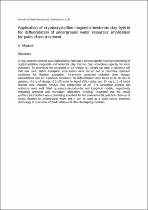 ResearchSpace
ResearchSpace
Application of cryptocrystalline magnesite-bentonite clay hybrid for defluoridation of underground water resources: implication for point of use treatment
JavaScript is disabled for your browser. Some features of this site may not work without it.
- ResearchSpace
- →
- Research Publications/Outputs
- →
- Journal Articles
- →
- View Item
| dc.contributor.author |
Masindi, Vhahangwele

|
|
| dc.date.accessioned | 2017-02-23T10:01:32Z | |
| dc.date.available | 2017-02-23T10:01:32Z | |
| dc.date.issued | 2016-07 | |
| dc.identifier.citation | Masindi, V. 2016. Application of cryptocrystalline magnesite-bentonite clay hybrid for defluoridation of underground water resources: implication for point of use treatment. Journal of Water Reuse and Desalination, 6(4) | en_US |
| dc.identifier.issn | 2220-1319 | |
| dc.identifier.uri | http://jwrd.iwaponline.com/content/early/2016/07/07/wrd.2016.055 | |
| dc.identifier.uri | http://hdl.handle.net/10204/8958 | |
| dc.description | Copyright: 2016 IWA Publishing. Due to copyright restrictions, the attached PDF file only contains the abstract of the full text item. For access to the full text item, please consult the publisher's website. The definitive version of the work is published in Journal of Water Reuse and Desalination, 6(4) | en_US |
| dc.description.abstract | A new synthesis method was established to fabricate a nanocomposite material comprising of cryptocrystalline magnesite and bentonite clay that has high adsorption capacity for ionic pollutants. To synthesize the composite at 1:1 weight (g): weight (g) ratio, a vibratory ball mill was used. Batch adsorption experiments were carried out to determine optimum conditions for fluoride adsorption. Parameters optimized included: time, dosage, concentration and pH. Optimum conditions for defluoridation were found to be 30 min of agitation, 0.5 g of dosage, 0.5:100 solid to liquid (S/L) ratios and 25 mg L-1 of initial fluoride ions. Fluoride removal was independent of pH. The adsorption kinetics and isotherms were well fitted by pseudo-second-order and Langmuir models, respectively indicating chemical and monolayer adsorption. Findings illustrated that the newly synthesized adsorbent was a promising adsorbent for the environmental pollution clean-up of excess fluoride in underground water and it can be used as a point source treatment technology in rural areas of South Africa and other developing countries. | en_US |
| dc.language.iso | en | en_US |
| dc.publisher | IWA Publishing | en_US |
| dc.relation.ispartofseries | Wokflow;17345 | |
| dc.subject | Water resource defluoridation | en_US |
| dc.subject | Ionic pollutants | en_US |
| dc.subject | Water reuse | en_US |
| dc.title | Application of cryptocrystalline magnesite-bentonite clay hybrid for defluoridation of underground water resources: implication for point of use treatment | en_US |
| dc.type | Article | en_US |
| dc.identifier.apacitation | Masindi, V. (2016). Application of cryptocrystalline magnesite-bentonite clay hybrid for defluoridation of underground water resources: implication for point of use treatment. http://hdl.handle.net/10204/8958 | en_ZA |
| dc.identifier.chicagocitation | Masindi, Vhahangwele "Application of cryptocrystalline magnesite-bentonite clay hybrid for defluoridation of underground water resources: implication for point of use treatment." (2016) http://hdl.handle.net/10204/8958 | en_ZA |
| dc.identifier.vancouvercitation | Masindi V. Application of cryptocrystalline magnesite-bentonite clay hybrid for defluoridation of underground water resources: implication for point of use treatment. 2016; http://hdl.handle.net/10204/8958. | en_ZA |
| dc.identifier.ris | TY - Article AU - Masindi, Vhahangwele AB - A new synthesis method was established to fabricate a nanocomposite material comprising of cryptocrystalline magnesite and bentonite clay that has high adsorption capacity for ionic pollutants. To synthesize the composite at 1:1 weight (g): weight (g) ratio, a vibratory ball mill was used. Batch adsorption experiments were carried out to determine optimum conditions for fluoride adsorption. Parameters optimized included: time, dosage, concentration and pH. Optimum conditions for defluoridation were found to be 30 min of agitation, 0.5 g of dosage, 0.5:100 solid to liquid (S/L) ratios and 25 mg L-1 of initial fluoride ions. Fluoride removal was independent of pH. The adsorption kinetics and isotherms were well fitted by pseudo-second-order and Langmuir models, respectively indicating chemical and monolayer adsorption. Findings illustrated that the newly synthesized adsorbent was a promising adsorbent for the environmental pollution clean-up of excess fluoride in underground water and it can be used as a point source treatment technology in rural areas of South Africa and other developing countries. DA - 2016-07 DB - ResearchSpace DP - CSIR KW - Water resource defluoridation KW - Ionic pollutants KW - Water reuse LK - https://researchspace.csir.co.za PY - 2016 SM - 2220-1319 T1 - Application of cryptocrystalline magnesite-bentonite clay hybrid for defluoridation of underground water resources: implication for point of use treatment TI - Application of cryptocrystalline magnesite-bentonite clay hybrid for defluoridation of underground water resources: implication for point of use treatment UR - http://hdl.handle.net/10204/8958 ER - | en_ZA |





